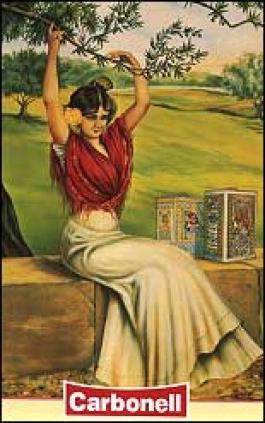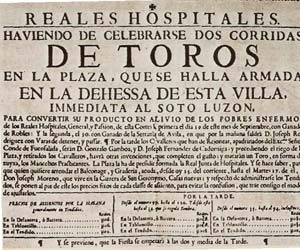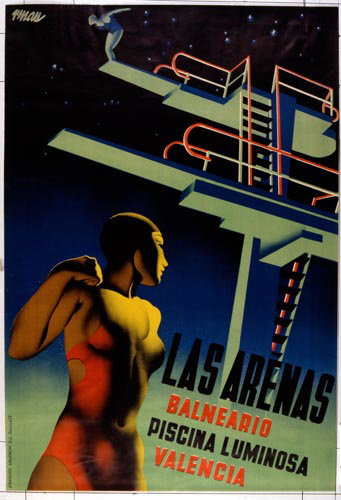The chulapa (A girl or a woman from Madrid, in traditional dress), carrying a hand of a monkey with a bottle of “Anis del mono” under his arm ……

The poster of Anis del Mono
a Cordoba Gypsy, clutching an olive branch of Carbonell….

The poster of Carbonell
and threadbare coat polyL

The poster of Polil
are iconic images of Spanish culture with over a century of moth --the moth only 66 years--, but even today still alive and active. All are images originally conceived as a promotional poster of these different brands, a stand that lived its years of splendor between the nineteenth and twentieth centuries and whose evolution analyzes poster in Spain.
The book Eguizábal Raul, Professor in Theory and History of Advertising School of Information Sciences at the Complutense University of Madrid, fills a gap in this area, because there was no work to offer a "global vision" on the poster in Spain, while attempting to "add value" this type of support, which is both "anthropological" document and "work of art", says its author to RTVE.es.
In “Poster in Spain”, Eguizábal reviewing in detail, and through more than 400 illustrations of posters, the evolution of this document throughout history as a "two-pronged" public, as a propaganda medium, and private commercial interest, which shows signs such as theater, cinema or bulls, and merchandise area where artists "enjoyed greater freedom" fall. However, historical moments in which war has dominated the cartel, and during the Civil War, with messages encouraging enlist on one side and on another side of the match.
"Royal Hospitals. Putting on two bullfights in the bull ring, which is armed in the pasture of this town, immediately to Soto Luzon to convert its product in relief of the sick poors of the Royal Hospitals (...) ". So reads the text of the poster oldest preserved in Spain, it dates from 1737 and was a bullfighting festival that was to be held in Madrid on 19 and 30 September.

A poster of Bullfighting
The poster, included in the book, belongs to the only genuinely Spanish gender, bulls, although its scope should be expanded to Hispanic area, accurate Eguizábal, who notes that this support has always had a "very international" character; hence the work is titled "Poster in Spain”.
That international character made that artists like Alphonse Mucha, the absolute master of Modernism poster, made posters for Spain like “cigarette paper Job” (1898) and the “chocolate Amatller” (1900), because were celebrated some very summoned competitions economically well endowed, that attracted authors from around the world.
But not only worked in Spain great poster artists, but our country gave birth to great artists who received international recognition, especially in one of the golden moments of this art in the modernist stage of late nineteenth-early twentieth centuries, as is the case of the Catalan Ramón Casas, who Eguizábal considered the most important of all. His is the sign of Anis del Mono, 1898, "sought by collectors around the world ".
Another prominent figure of Modernism is Alexander Riquer, an artist shaped like Casas in Paris, and whose poster was second in the competition for the brand of anise.
In addition, the professor recalls that many great Spanish painters, such as Pablo Picasso and Salvador Dali, cultivated the poster art.
In the second golden age of the poster in Spain, between the decades of the 20s and 30s of the twentieth century, where design reaches its "higher technical level", also names arise from international stature as the Valencian Josep Renau, author of large movie posters that would then performing in exile, in Mexico. Renau is precisely the favorite poster author of “the pool Las Arenas”, held in 1932 and described as "a masterpiece of the poster in Spain", which can be an athletic woman in a bathing suit in front of a trampoline and following the influence of Soviet cinema and Russian avant-garde.

The poster of The pool Las Arenas
Eguizábal also reviews, in his work, those posters that have been in the popular imagination, as cited Anis del Mono, the Carbonell by Pere Abarca 1915, --which continues to use the oilcan as a trade – mark--, the polyl by Artigas (1948 ), along with the fat and skinny of Chocolates Ortego, by Matias Lopez, (1871 ), the elephant of Orion insecticides, by Clapera of 1945, or the sheep of Norit.
To the Professor of Theory and History of Advertising is hard to guess why these posters have managed to stay alive over time, then, in most cases, they are not the highest artistic quality, but "those who have known themselves synthesize the message in a simple image"; in addition to "something that touches certain springs public awareness", as the threadbare coat polyL, in the 40s, when the Spaniards had a hole in his stomach.
According Eguizábal, is now "much more difficult " this may occur, because the cartel no longer has that communicative role, which began to lose when television became a mass medium.
However, that does not mean that the cartel has no future. In fact, for the author of the book, and considering that a different time we live, the poster has a good time, but in the cultural field, to announce concerts, plays and films, demonstrations, that "wallpaper" the walls of universities and streets, as also "it has never been easier to make a poster" and you only need to have a printer at home.
"The poster does not have a bad time and this will continue so, because it has found its niche and is comfortable", he concludes.
Well, I hope that you have liked this post.
Till soon, kind regards,
Luis.
Sponsored by Costaluz Lawyers.
Please click down here:
